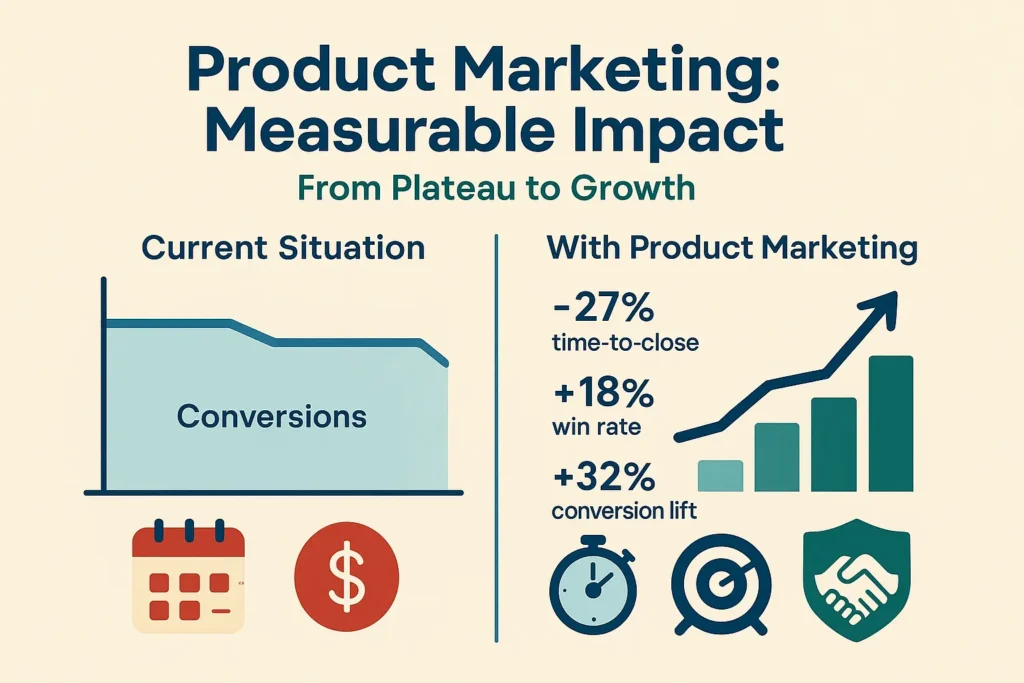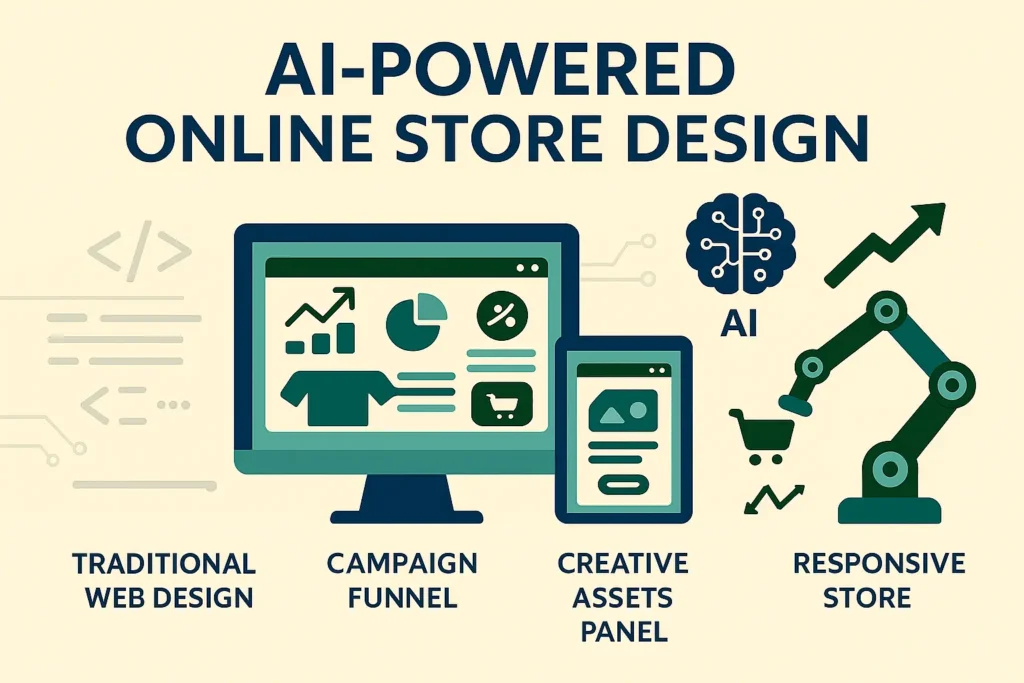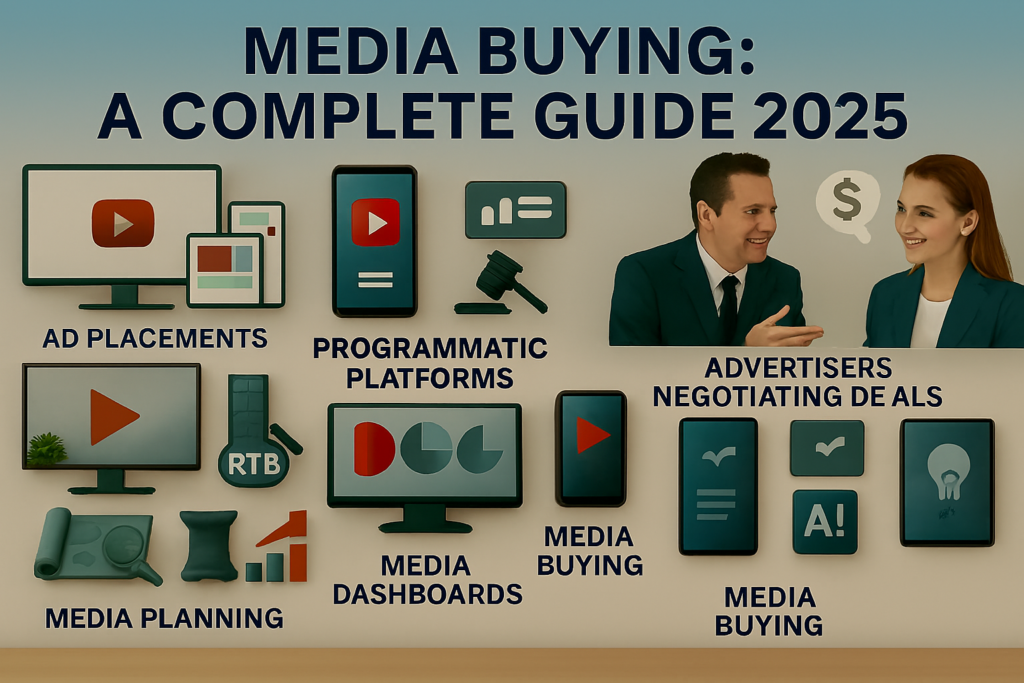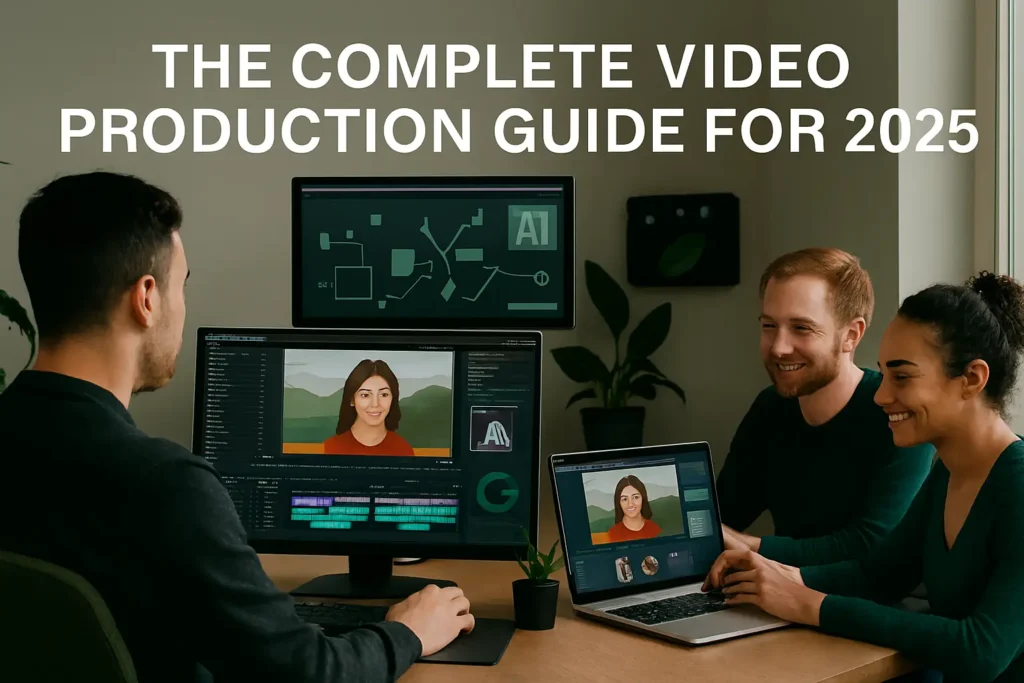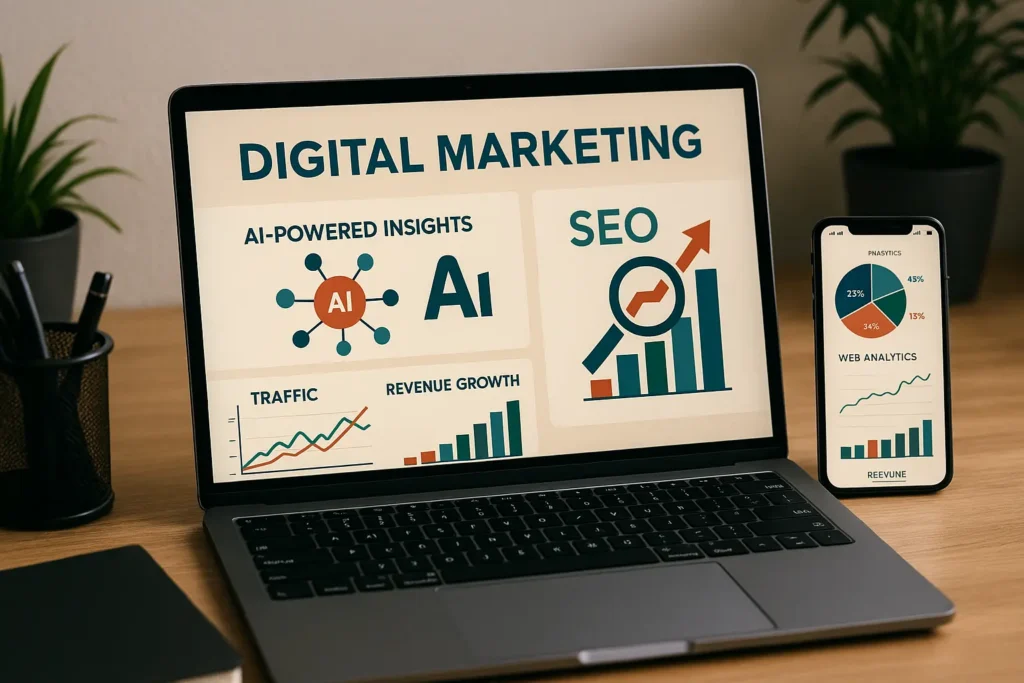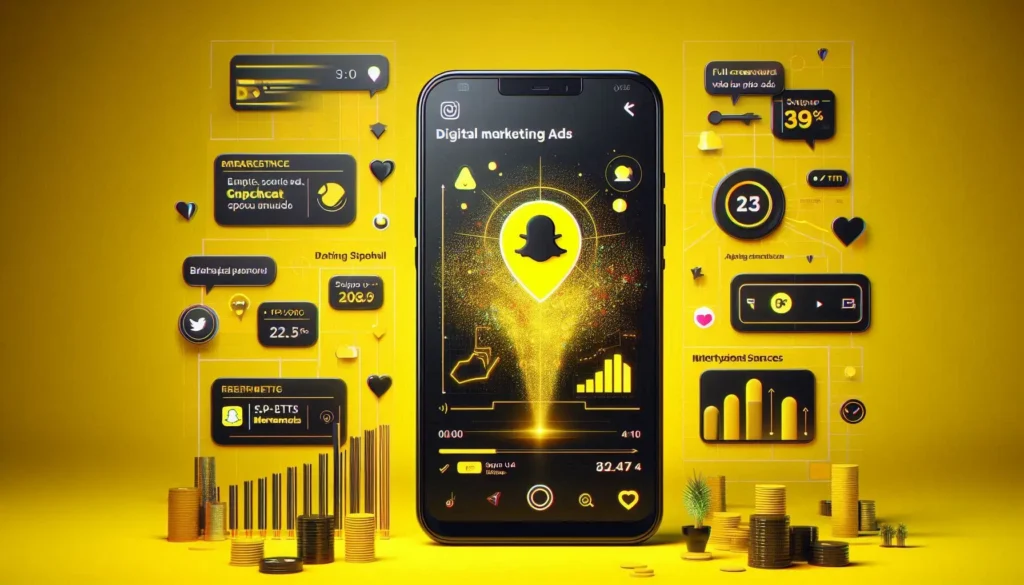
Get More Leads with Our Proven Content Marketing Strategies
Why Content Marketing is Your Lead Generation Game-Changer
Content marketing represents a fundamental shift in how businesses approach lead generation. Unlike traditional outbound marketing tactics that interrupt potential customers, content marketing attracts them by providing genuine value. The statistics speak for themselves: content marketing costs 62% less than traditional outbound marketing while generating three times more leads.
This dramatic difference in both cost and effectiveness stems from how modern buyers conduct their research. Today’s consumers complete 83% of their research before ever contacting a company. They’re actively seeking information, solutions, and insights that can help them make informed decisions. By creating valuable content that addresses their needs at each stage of this journey, you position your business as a trusted resource rather than just another vendor.
The compound effect of content marketing sets it apart from other lead generation strategies. While a paid advertisement stops generating leads the moment you stop paying for it, a well-crafted piece of content can continue attracting and converting visitors for months or even years. We’ve seen blog posts from 2020 that still generate qualified leads today, demonstrating the long-term value of strategic content creation.
Content marketing also builds trust and authority in ways that traditional advertising simply cannot. When you consistently provide helpful, actionable information, potential customers begin to see you as an expert in your field. This trust is invaluable when it comes time for them to make a purchasing decision.
The Foundation: Know Your Audience Before You Create
Before diving into content creation, successful content marketers invest a significant amount of time in understanding their target audience. This foundation determines whether your content will resonate with potential customers or fall flat in an oversaturated market.
Creating detailed buyer personas based on real customer data forms the cornerstone of effective content marketing. These personas go beyond basic demographics to include pain points, challenges, goals, and behavioral patterns. We recommend conducting interviews with existing customers, analyzing support tickets, and reviewing sales call recordings to gather authentic insights about your audience’s needs and motivations.
Understanding where your audience consumes content is equally crucial. Are they scrolling through LinkedIn during their lunch break? Reading industry publications on their commute? Watching YouTube tutorials while working from home? Each platform has its own content preferences and consumption patterns. A thorough understanding of these preferences allows you to create content that fits naturally into your audience’s daily routines.
Mapping content to different stages of the buyer’s journey ensures you’re providing the right information at the right time. Someone in the awareness stage needs educational content that helps them understand their problem, while someone in the consideration stage wants to compare solutions and evaluate options. Decision-stage content should address specific objections and provide the final push toward conversion.
Competitor research reveals content gaps and opportunities in your market. By analyzing what topics your competitors cover, how they present information, and where they fall short, you can identify whitespace opportunities to differentiate your content and provide superior value to your shared audience.
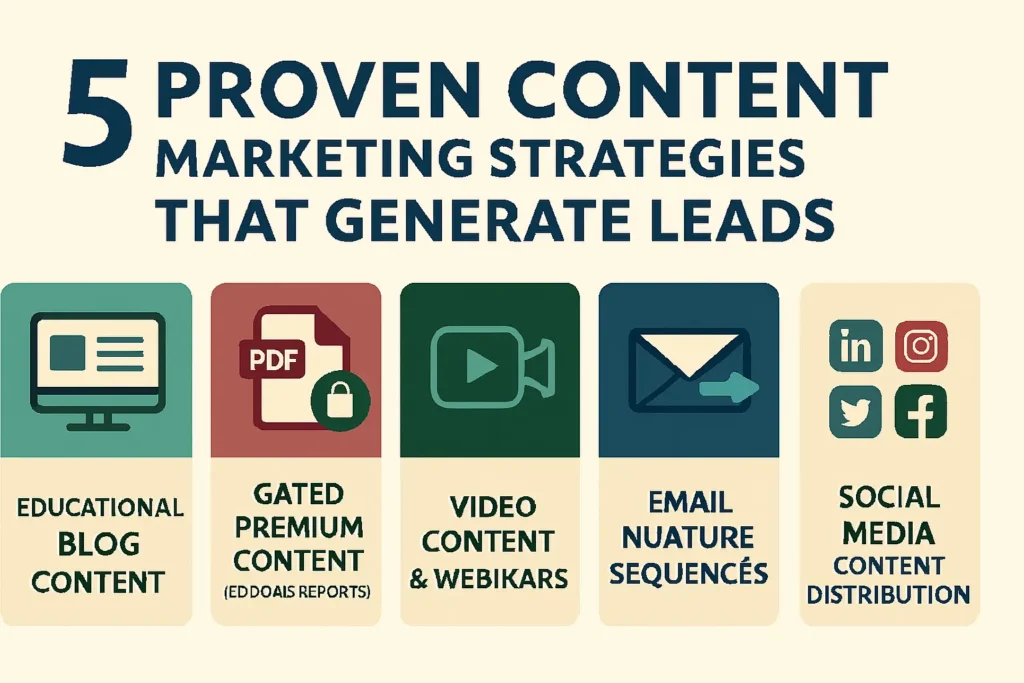
5 Proven Content Marketing Strategies That Generate Leads
Educational Blog Content: The Traffic Generation Engine
Educational blog content optimized for search engines serves as the foundation of most successful content marketing strategies. These problem-solving articles attract visitors who are actively searching for solutions, making them highly qualified potential leads.
The key to effective educational content lies in understanding search intent and creating comprehensive resources that fully address user queries. Rather than writing thin, keyword-stuffed articles, focus on creating in-depth guides that become the definitive resource on specific topics within your industry.
We’ve found that evergreen educational content performs exceptionally well for lead generation. Topics like “how to optimize your website for conversions” or “the complete guide to email marketing automation” continue attracting organic traffic months after publication. Each visitor represents a potential lead who has already demonstrated interest in your area of expertise.
Gated Premium Content: Quality Over Quantity
Gated premium content—such as ebooks, whitepapers, and industry reports—represents some of the highest-converting content types for lead generation. These resources offer substantial value in exchange for contact information, creating a fair value exchange that visitors are willing to make.
The most successful gated content solves immediate, specific problems for your target audience. A comprehensive template, detailed case study, or exclusive industry research provides enough value to justify the “cost” of sharing contact information. The key is ensuring the content delivers on its promise and provides actionable insights visitors can implement immediately.
We’ve seen conversion rates as high as 40% on well-designed landing pages promoting high-value gated content. The secret lies in clearly communicating the specific benefits and outcomes the content provides, using compelling headlines and social proof to build credibility.
Video Content and Webinars: Building Personal Connections
Video content and webinars create opportunities for deeper engagement and relationship building that other content formats cannot match. When prospects can see and hear from your team members, it builds trust and familiarity that translates into higher conversion rates.
Webinars particularly excel at lead generation because they require a higher level of commitment from attendees. Someone willing to dedicate 30-60 minutes to your presentation has demonstrated significant interest in your topic and solutions. This makes webinar attendees some of the most qualified leads you can generate.
The real-time interaction possible in webinars allows you to address specific objections and questions, moving prospects further along the sales funnel during the presentation itself. Follow-up sequences for webinar attendees consistently show higher engagement rates than other content types.
Email Nurture Sequences: Converting Interest Into Action
Email nurture sequences bridge the gap between content consumption and sales conversations. These automated sequences deliver targeted content based on subscriber behavior and interests, gradually building trust and moving prospects toward a purchase decision.
The most effective nurture sequences feel personal and relevant, delivering content that directly addresses the subscriber’s current stage in the buyer’s journey. Someone who downloaded an introductory guide needs different follow-up content than someone who attended a product demo.
We’ve found that nurture sequences combining educational content with subtle product positioning achieve the best results. Rather than immediately pushing for a sale, these sequences provide ongoing value while demonstrating your expertise and the effectiveness of your solutions.
Social Media Content Distribution: Amplifying Your Reach
Social media content distribution amplifies your reach and creates multiple touchpoints with potential leads. Each platform offers unique opportunities to engage with prospects and drive traffic back to your conversion-optimized content.
The key to social media success lies in adapting your content to each platform’s native format and audience expectations. A LinkedIn article requires a different approach than an Instagram post or Twitter thread. Understanding these nuances allows you to maximize engagement and drive quality traffic to your lead generation assets.
Social media also provides valuable opportunities for engagement and relationship building. Responding to comments, participating in discussions, and sharing user-generated content create a sense of community around your brand that traditional marketing cannot replicate.
Keep reading and uncover secrets that can change the way you work. Top Search Engine Marketing Solutions for Businesses in Riyadh – AI-Driven Campaigns
Content Types That Convert Visitors into Leads
High-Converting Lead Magnets: Immediate Problem Solvers
High-converting lead magnets solve immediate, specific problems for your target audience. Checklists, templates, and step-by-step guides provide instant value that visitors can use right away, making the value exchange clear and compelling.
The most successful lead magnets are highly specific rather than broadly applicable. Instead of offering a generic “marketing checklist,” create a “complete pre-launch checklist for SaaS companies” that addresses the exact needs of your target audience. This specificity increases perceived value and attracts more qualified leads.
We consistently see higher conversion rates on lead magnets that promise specific outcomes or time savings. “Cut your content creation time in half with this template” is more compelling than “improve your content creation process.”
Case Studies and Success Stories: Social Proof That Converts
Case studies and success stories provide the social proof necessary to convert skeptical prospects into leads. These content pieces demonstrate real results from real customers, addressing the natural skepticism that comes with evaluating new solutions.
The most effective case studies follow a clear structure: challenge, solution, and results. They provide specific, quantifiable outcomes that prospects can envision for their situations. Including direct quotes from customers adds authenticity and credibility that generic testimonials cannot match.
We’ve found that case studies perform particularly well when they feature customers similar to your target prospects. A small business owner is more likely to be influenced by a case study featuring another small business than one showcasing a Fortune 500 company.
Interactive Content: Engagement That Captures Information
Interactive content such as quizzes, assessments, and calculators engages visitors in ways that static content cannot. These tools require active participation, increasing time on site and creating natural opportunities to capture contact information.
The most successful interactive content provides personalized results based on user inputs. A marketing ROI calculator that shows specific potential returns based on a prospect’s current situation creates immediate value and demonstrates your tool’s capabilities.
Interactive content also generates valuable data about prospects’ needs and challenges. Quiz responses and assessment results provide insights that can inform follow-up communications and help sales teams prioritize leads.
Thought Leadership Content: Building Authority and Trust
Thought leadership content positions your brand as an industry authority while attracting prospects who value expertise and innovation. This content type works particularly well for complex B2B sales where trust and credibility are crucial factors in the decision-making process.
Effective thought leadership content takes a unique perspective on industry trends, challenges conventional wisdom, or provides exclusive insights based on proprietary research. It goes beyond reporting on industry news to provide original analysis and predictions that help readers understand what’s coming next.
We’ve seen thought leadership content generate leads from senior decision-makers who rarely engage with other content types. These prospects are often looking for strategic insights rather than tactical advice, making thought leadership an essential component of comprehensive content strategies.
How-to Guides and Tutorials: Educational Content That Converts
How-to guides and tutorials attract prospects who are actively trying to solve specific problems. These content pieces provide step-by-step instructions that deliver immediate value while showcasing your expertise and methodology.
The most effective tutorials strike a balance between being comprehensive enough to be useful and complex enough to demonstrate the value of professional assistance. A guide that solves a simple problem completely might not generate leads, while one that highlights the complexity of a broader challenge can drive prospects to seek expert help.
We consistently see strong conversion rates on tutorial content that includes templates, tools, or resources that complement the instructions. These add-ons create natural opportunities to capture contact information while providing additional value.
Keep reading and uncover secrets that can change the way you work. Secrets of Successful E-Commerce Marketing: What Your Competitors Are Doing That You Don’t Know?
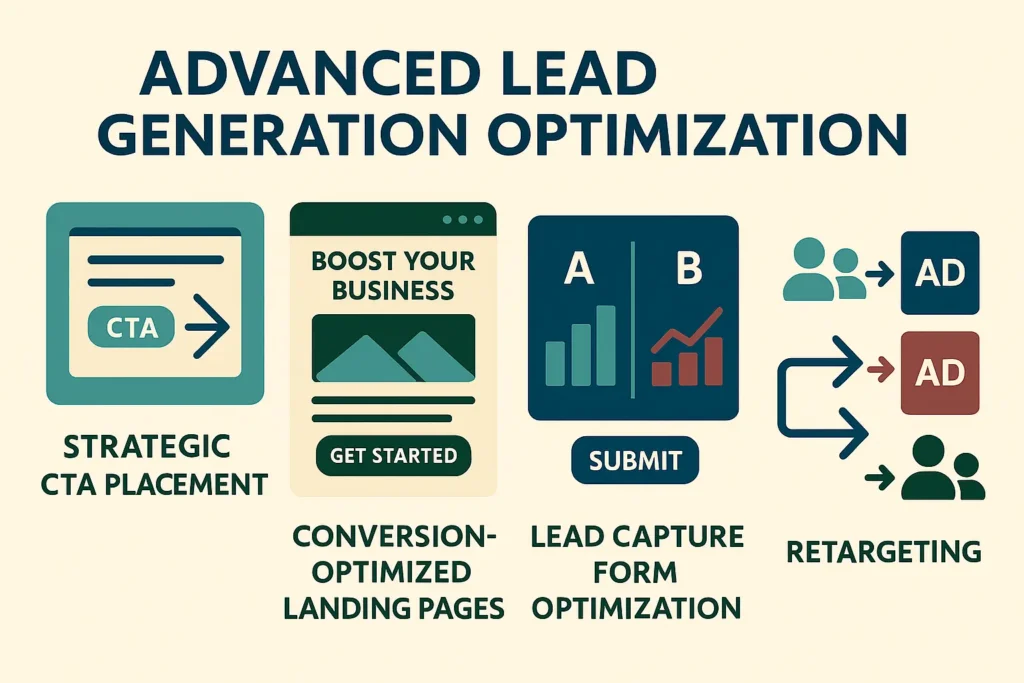
Optimize Your Content for Maximum Lead Generation
Strategic Call-to-Action Placement
Strategic placement of clear, compelling calls-to-action throughout your content dramatically impacts lead generation performance. The most effective CTAs feel natural and relevant to the content context rather than forced or promotional.
Multiple CTAs throughout longer content pieces capture leads at different engagement levels. Some visitors will be ready to convert after reading your introduction, while others need to consume your entire piece before taking action. Providing multiple opportunities increases overall conversion rates.
We’ve found that CTAs positioned after valuable insights or key takeaways perform particularly well. These strategic placements capitalize on moments when readers are most engaged and see the highest value in your content.
Conversion-Optimized Landing Pages
Creating conversion-optimized landing pages for gated content ensures that traffic from your content marketing efforts converts into leads. These pages should eliminate distractions and focus entirely on communicating the value of your offer.
The most effective landing pages use clear, benefit-focused headlines that immediately communicate what visitors will receive. Supporting copy should address potential objections and reinforce the value proposition without overwhelming visitors with unnecessary information.
Visual elements such as mockups, screenshots, or video previews help visitors understand exactly what they’re getting in exchange for their contact information. This transparency builds trust and increases conversion rates.
Lead Capture Form Optimization
Optimizing lead capture forms involves finding the right balance between gathering useful information and minimizing friction. Too many form fields can discourage conversions, while too few may not provide enough information for effective follow-up.
We typically recommend starting with just a name and email address for top-of-funnel content, then gradually requesting more information as prospects move through your nurture sequence. This progressive profiling approach maximizes initial conversion rates while still gathering comprehensive prospect data over time.
Form design and copy also significantly impact conversion rates. Clear labels, logical field ordering, and compelling submit button text all contribute to higher conversion rates.
A/B Testing for Continuous Improvement
A/B testing headlines, CTAs, and content formats provides data-driven insights for improving conversion rates. Even small improvements can have significant impacts on lead generation when applied across multiple content pieces.
The most valuable tests focus on elements that directly impact conversion decisions. Testing different value propositions, CTA copy, or form designs typically yields more actionable insights than testing minor design elements.
We recommend focusing on one variable at a time to ensure clear, actionable results. Testing multiple elements simultaneously makes it difficult to identify which changes drove performance improvements.
Retargeting for Non-Converters
Implementing retargeting campaigns re-engages content consumers who haven’t converted, providing additional opportunities to capture leads from your existing traffic. These campaigns can promote different content offers or present the same offer with new messaging.
The most effective retargeting campaigns segment audiences based on their content consumption behavior. Someone who read a beginner’s guide needs different follow-up content than someone who downloaded an advanced whitepaper.
We’ve seen significant improvements in overall conversion rates when retargeting campaigns complement organic content marketing efforts. These campaigns ensure that valuable traffic doesn’t go to waste when visitors aren’t ready to convert during their initial visit.
Keep reading and uncover secrets that can change the way you work. How to Benefit from Digital Marketing and SEO
Turn Your Content Marketing into a Lead Generation Machine
Systems for Consistent Creation and Distribution
Setting up systems for consistent content creation and distribution ensures that your lead generation efforts compound over time. The most successful content marketing programs operate like well-oiled machines, consistently producing and promoting high-quality content.
A comprehensive content calendar aligned with sales cycles and seasonal trends helps maintain consistency while ensuring timely, relevant content. This planning allows for better resource allocation and coordination across marketing and sales teams.
We recommend establishing clear workflows for content creation, review, and promotion. These systems reduce the time and effort required to maintain consistent output while improving overall quality.
Measuring and Tracking Key Metrics
Measuring and tracking key metrics provides insights necessary for optimizing your content marketing strategy. The most important metrics focus on lead quality rather than just quantity, ensuring that your content attracts prospects who are likely to become customers.
Traffic, conversion rates, and lead quality all provide different insights into content performance. A piece that generates significant traffic but few conversions may need CTA optimization, while content that converts well but attracts little traffic might benefit from better promotion.
We track lead-to-customer conversion rates, time to close, and average deal size for content-generated leads to understand the full impact of content marketing on business results.
Repurposing for Maximum Impact
Repurposing successful content across multiple formats and channels maximizes the return on your content creation investment. A single piece of research can become a blog post, infographic, video, social media series, or webinar topic.
The most effective repurposing strategies adapt content to different platforms and audience preferences rather than simply copying and pasting. Each format should be optimized for its specific use case and audience expectations.
We’ve found that repurposing high-performing content often yields better results than creating entirely new content. This approach allows you to double down on proven topics while expanding your reach across different channels.
Building Content Calendars That Drive Results
Building content calendars that align with sales cycles and seasonal trends ensures your content supports broader business objectives. The most effective calendars coordinate content topics with sales initiatives and marketing campaigns.
Seasonal trends and industry events provide natural opportunities for timely, relevant content that attracts engaged audiences. Planning content around these events allows you to capitalize on increased interest and search volume.
We recommend creating content calendars that balance evergreen topics with timely, trend-driven content. This approach ensures consistent lead generation while allowing for opportunistic content that can generate immediate results.
Scaling Successful Strategies
Scaling successful strategies while continuously testing new approaches allows you to grow your lead generation results over time. The most successful content marketing programs identify what works and systematically expand those efforts.
This scaling process involves both increasing the volume of successful content types and expanding into new channels and formats. However, scaling should never come at the expense of quality, as poor content can damage your brand reputation and lead generation.
We recommend establishing quality thresholds and review processes that ensure consistent standards as you scale your content production. This approach maintains the effectiveness that made your initial content successful.
Turn your goals into real achievements with our tailored services – request the service now.
Frequently Asked Questions
How long does it take to see results from content marketing for lead generation?
Content marketing for lead generation typically shows initial results within 3-6 months, with significant momentum building over 6-12 months. However, some immediate wins are possible through paid promotion and email marketing to existing audiences.
The timeline depends heavily on your industry, competition, and content quality. Businesses in less competitive niches may see results more quickly, while those in saturated markets may need longer to establish authority and gain traction.
We’ve found that consistency matters more than perfection in the early stages. Companies that publish regular, valuable content typically see better results than those that publish sporadically, even if individual pieces are higher quality.
What’s the best type of content for B2B lead generation?
Educational blog posts, case studies, and gated resources like whitepapers and industry reports tend to perform best for B2B lead generation. These content types address the longer sales cycles and research-heavy buying processes common in B2B markets.
The most effective B2B content focuses on business outcomes rather than product features. Content that demonstrates ROI, efficiency improvements, or risk reduction resonates particularly well with B2B buyers who need to justify their purchasing decisions.
We consistently see strong performance from content that addresses specific industry challenges or regulatory requirements. This targeted approach attracts highly qualified leads who are actively searching for solutions to pressing business problems.
How many leads can I expect from content marketing?
Results vary widely based on industry, target audience, content quality, and promotion strategy. However, successful content marketing can generate three times more leads than traditional marketing at 62% lower cost.
Realistic expectations for established content marketing programs range from 20-50 leads per month for small businesses to hundreds or thousands for larger companies with comprehensive strategies. The key is focusing on lead quality rather than just quantity.
We recommend starting with modest goals and scaling based on results. A program that generates 10 high-quality leads per month is more valuable than one that generates 100 unqualified leads.
Should I focus on free or gated content for lead generation?
Use a strategic mix of both free and gated content for optimal results. Free content builds audience and trust while establishing your expertise, while gated content captures contact information from qualified prospects.
The most effective strategy uses free content to attract visitors and demonstrate value, then offers related gated content for those who want deeper insights. This approach maximizes both reach and conversion opportunities.
We typically recommend a ratio of 3:1 or 4:1 free to gated content, ensuring that you’re providing substantial value before asking for contact information. This balance builds trust while still capturing leads from engaged prospects.
How do I know if my content marketing is generating quality leads?
Track lead-to-customer conversion rates, time to close, and average deal size from content-generated leads compared to other sources. Quality leads from content marketing typically show higher engagement rates and shorter sales cycles.
The most reliable indicators include email engagement rates, content consumption patterns, and sales team feedback about lead quality. Prospects who consume multiple pieces of content before converting typically represent higher-quality leads.
We recommend implementing lead scoring systems that consider both demographic information and behavioral data. This approach helps sales teams prioritize follow-up efforts and provides insights into which content types generate the most qualified prospects.

